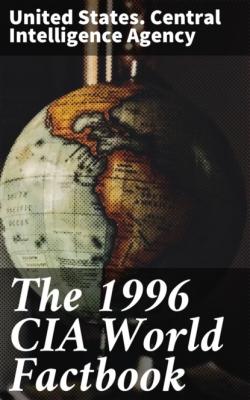The 1996 CIA World Factbook. United States. Central Intelligence Agency
Читать онлайн.| Название | The 1996 CIA World Factbook |
|---|---|
| Автор произведения | United States. Central Intelligence Agency |
| Жанр | Социология |
| Серия | |
| Издательство | Социология |
| Год выпуска | 0 |
| isbn | 4057664582324 |
Area:
total area: 342,000 sq km
land area: 341,500 sq km
comparative area: slightly smaller than Montana
Land boundaries:
total: 5,504 km
border countries: Angola 201 km, Cameroon 523 km, Central African
Republic 467 km, Gabon 1,903 km, Zaire 2,410 km
Coastline: 169 km
Maritime claims: territorial sea: 200 nm
International disputes: long segment of boundary with Zaire along
the Congo River is indefinite (no division of the river or its
islands has been made)
Climate: tropical; rainy season (March to June); dry season (June
to October); constantly high temperatures and humidity; particularly
enervating climate astride the Equator
Terrain: coastal plain, southern basin, central plateau, northern
basin
lowest point: Atlantic Ocean 0 m
highest point: Mount Berongou 903 m
Natural resources: petroleum, timber, potash, lead, zinc, uranium,
copper, phosphates, natural gas
Land use:
arable land: 2%
permanent crops: 0%
meadows and pastures: 29%
forest and woodland: 62%
other: 7%
Irrigated land: 40 sq km (1989)
Environment:
current issues: air pollution from vehicle emissions; water
pollution from the dumping of raw sewage; tap water is not potable;
deforestation
natural hazards: seasonal flooding
international agreements: party to - Endangered Species, Ozone Layer
Protection, Tropical Timber 83; signed, but not ratified -
Biodiversity, Climate Change, Desertification, Law of the Sea,
Tropical Timber 94
Geographic note: about 70% of the population lives in Brazzaville,
Pointe Noire, or along the railroad between them
People———
Population: 2,527,841 (July 1996 est.)
Age structure:
0–14 years: 43% (male 550,971; female 545,096)
15–64 years: 53% (male 657,035; female 688,441)
65 years and over: 4% (male 34,973; female 51,325) (July 1996 est.)
Population growth rate: 2.19% (1996 est.)
Birth rate: 39.19 births/1,000 population (1996 est.)
Death rate: 17.35 deaths/1,000 population (1996 est.)
Net migration rate: 0 migrant(s)/1,000 population (1996 est.)
Sex ratio:
at birth: 1.03 male(s)/female
under 15 years: 1.01 male(s)/female
15–64 years: 0.95 male(s)/female
65 years and over: 0.68 male(s)/female
all ages: 0.97 male(s)/female (1996 est.)
Infant mortality rate: 108.1 deaths/1,000 live births (1996 est.)
Life expectancy at birth: total population: 45.77 years male: 44.21 years female: 47.37 years (1996 est.)
Total fertility rate: 5.15 children born/woman (1996 est.)
Nationality:
noun: Congolese (singular and plural)
adjective: Congolese or Congo
Ethnic divisions: south: Kongo 48% north: Sangha 20%, M'Bochi 12% center: Teke 17%, Europeans 8,500 (mostly French)
Religions: Christian 50%, animist 48%, Muslim 2%
Languages: French (official), African languages (Lingala and
Kikongo are the most widely used)
Literacy: age 15 and over can read and write (1995 est.)
total population: 74.9%
male: 83.1%
female: 67.2%
Government—————
Name of country:
conventional long form: Republic of the Congo
conventional short form: Congo
local long form: Republique Populaire du Congo
local short form: Congo
former: Congo/Brazzaville
Data code: CF
Type of government: republic
Capital: Brazzaville
Administrative divisions: 9 regions (regions, singular - region) and 1 commune*; Bouenza, Brazzaville*, Cuvette, Kouilou, Lekoumou, Likouala, Niari, Plateaux, Pool, Sangha
Independence: 15 August 1960 (from France)
National holiday: Congolese National Day, 15 August (1960)
Constitution: new constitution approved by referendum March 1992
Legal system: based on French civil law system and customary law
Suffrage: 18 years of age; universal
Executive branch:
chief of state: President Pascal LISSOUBA (since August 1992);
elected for a five-year term by universal suffrage; election last
held NA August 1992 (next to be held NA August 1997); results -
President Pascal LISSOUBA won 61% of the vote
head of government: Prime Minister Jacques Joachim YHOMBI-OPANGO
(since 23 June 1993) appointed by the president
cabinet: Council of Ministers appointed by the president
Legislative branch: bicameral
National Assembly (Assemblee Nationale): election last held 3
October 1993 (next to be held NA); results - percent of vote by
party NA; seats - (125 total) UPADS 64, URD/PCT 58, others 3
Senate: election last held 26 July 1992 (next to be held NA July
1998); results - percent of vote by party NA; seats - (60 total)
UPADS 23, MCDDI 14, RDD 8, RDPS 5, PCT 2, others 8
Judicial branch: Supreme Court (Cour Supreme)
Political parties and leaders: of Congo's many political parties,
the most important are Congolese Labor Party (PCT), Denis
SASSOU-NGUESSO, president; Association for Democracy and Development
(RDD), Joachim Yhombi OPANGO, president; Association for Democracy
and Social Progress (RDPS), Jean-Pierre Thystere TCHICAYA,
president; Congolese Movement for Democracy and Integral Development
(MCDDI), Bernard KOLELAS, leader; Pan-African Union for Social
Development (UPADS), Pascal LISSOUBA, leader; Union of Democratic
Forces (UFD), David Charles GANAO, leader; Union for Democratic
